





Daphne is a lady I know, with whom I chat about gardening. Not too long ago, whilst parting with a young Jacaranda in return for some Sweetshade seed, she mentioned her intention to wait for the right moon to plant them. Naturally, I was interested.
"It's proven," she said. "The moon helps seeds germinate, if you plant them at the right time."
I was left intrigued. Like many gardeners, I'd heard of this concept here & there, but never in great detail. And again like many gardeners, I'd experienced my share of failure when it came to germination. Hard lessons in the garden had taught me to keep ears & eyes open.
So, what moon is the right moon?
Does it really work?
It wasn't long before I was reading up & asking around. Almost immediately, it became clear that proponents of moon gardening are many & widespread. There are dozens of books & web sites dedicated to the practice, many offering moon phase calendars & other lunar paraphernalia. Reputable media sources such as National Geographic [1] had lent credibility to the notion through articles & factsheets. In places such as the Old Farmer's Almanac, gardeners were vouching for years of successful moon planting & every experienced gleaner I knew & asked directly was quick to provide reassurance.
"Yeah, its an old farmers' way," went the typical response." They reckon it works, but who has time for that now?"
Since ancient times it seems, agricultural societies have followed the moon both through calendars & in farming practices. The Mayan civilisation is a perfect example, with its moon calendar by which the planting & harvesting of maize was plotted over the course of many years.[2] Even to the modern day, lunar-guided traditions are being passed down through rural families in many countries; including the United States.[3]
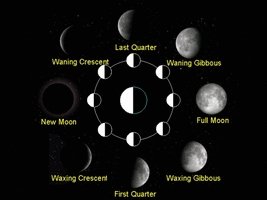
Opinions are divided over the credibility of the entire notion of lunar gardening. On one hand, there are generations of tradition behind the practice & many prepared to vouch for it today. On the other hand, there are scientific arguments against the main tenants that should not be ignored.
When we think of the moon & the effect that she has on the Earth, ocean tides are usually the first things that spring to mind. To a lesser a degree, we are aware that the moon also affects weather patterns, the highest amounts of rainfall correlating with new & full moons. We think least about the effect of lunar gravitational forces on land however, though our understanding of physics dictates there must be one. Whilst they are imperceptible to us, land tides do exist & follow the course of the moon in a similar manner to the oceans. The degree to which the moon raises land mass is still debated, but most assertions stand somewhere between 10 & 20 cm (4 - 9").[4]
It stands to the same reason that soil moisture would be affected by the moon in some way. Caren Catterall from Gardeningbythemoon.com tells us ...
"The lunar phase controls the amount of moisture in the soil. The moisture is at its peak at the time of the new & full moon. (sic) Just as the moon pulls the tides in the ocean, it also pulls upon the subtle bodies of water, causing moisture to rise in the earth, which encourages germination & growth."
E. A. Crawford, author of "The Lunar Garden: Planting by the Moon Phases" says ...
"Any gardener knows the importance of the soil's water content to a germinating seed. It makes sense to consider when planting your garden, the pull of the moon (sic). Not only does the gravitational pull of the moon affect the tides & rainfall, but it affects the air currents on the surface of the earth as well. Plants are extremely sensitive to any tiny energy fluctuation."
On the surface, water tables rising with the moon seems feasible but there is a problem in the science. In simple terms, our understanding of tidal forces state that effected bodies must be large enough to be pulled by the moon from opposite ends. Wikipedia, the online encyclopedia explains, ...
"The tidal force is a secondary effect of the force of gravity and is responsible for the tides. It arises because the gravitational acceleration experienced by a large body is not constant across its diameter. One side of the body has greater acceleration than its center of mass, and the other side of the body has lesser acceleration."
This implies that tidal forces on land would act differently according to the size of different continents. A huge land mass like Eurasia would be most subject to land tides whereas islands & other smaller bodies would not be affected at all. Whilst this argument can be fairly aimed at moon gardening to a degree, it far from shuts the door on the practice. The majority of the world's fresh water lies underground, including some of the largest rivers & subterranean seas such as the Great Artesian Basin. How the moon may effect both large & small bodies of moisture beneath the ground has not been fully studied. It is also important to remember that gravitation is not the only possible explaination. Other than a direct lunar influence, improved germination during waxing moons may reflect an evolved characterstic of plants. Mangrove trees which drop their seeds at high tide prove that at least some interaction between plants & the lunar cycle does exist. There are also atmospheric phenomena to consider, along with the possibility of other environmental factors we are yet to understand.
Regardless of the arguments, what matters is results & traditions of planting & harvesting by the moon rest upon generations of experience. Rather than questioning theories, farmers over the centuries have taken a pragmatic approach to observing natural cues. Whilst a falling leaf does not cause autumn, it is a reliable sign of the season. In the same way, a practical approach to following the moon may bring its own rewards.
Conventionally, there eight moon phases but for practical purposes moon gardeners have simplified these into four. The first two quarters track the moon's progress from the shadowy New Moon to the shining Full Moon. This is called waxing. The return journey through the third & fourth phases is called waning. In describing the significance of phases, moon gardeners exhibit some variety but remain consistent in one principle. The two waxing quarters represent a period of growth peaking at the Full Moon. The waning quarters are for harvesting, pruning & other slow-growth activities.
Waxing
Waning
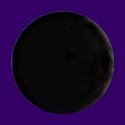
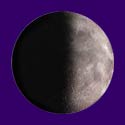
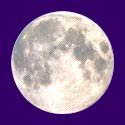
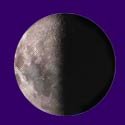
Images courtesy of
Gardeningbythemoon.comThe first step to gardening by the moon is attuning with the lunar cycle. It is normal to keep track of days of the week & months of the year, but keeping track of lunar phases is a habit that not many keep. As well as passing through phases, Lunar also rises, sets & sometimes appears by day. The times of moon rises & sets can usually be found in local newspapers & of course, on many web sites such as this USNO page that produces yearly sun & moon tables based on both US or worldwide locations. The amount of time the moon spends in the sky by day is important to note. A surprisingly common misconception of moon gardening is that it is a nocturnal pursuit. Gardening at night has advantages where circumstances allow it but it is not related to moon gardening in particular. Moon gleaners need only observe the phases when planning normal gardening activities.
The moon is at her point of least influence when new. From here, her pull increases as she journeys toward full. Traditional practices have seen growers planting at the full moon, probably because our forebears have noticed seed germinating more quickly at that time. Contemporary wisdom tends toward planting from the 1st quarter however, to ensure germination & increased growth over the course of the waxing moon. Proponents of moon gardening urge the planting of leafy vegetables during the 1st quarter, along with other plants that bear fruit with external seeds.
Over the 2nd quarter, the modern practice is planting varieties with fruits that bear internal seed. These include some vegetables like peas & beans, most common fruits such as apples & oranges & also those we call vegetables, but are really fruit ie. peppers, cucurbits & so on. This is the traditional peak planting period & it does remain so for many moon growers, particularly farmers. Some moon gardeners also say to harvest at the full moon, whilst moisture is at its peak. Others wait for the end of the lunar cycle. This choice would likely depend on the crop in question & the effect harvesting has on the parent plant. If you want juicy tomatoes, try picking them at the full moon. If you plan to harvest beans for drying, perhaps the 4th quarter is better. The beauty of moon gardening is that it is not an exact science, so there is room to experiment.
The moon wanes from full, exerting a diminishing influence. Moon gardeners believe that plants naturally focus development on root systems from this time, employing the 3rd quarter to plant root vegetables, bulbs & other plants that depend on root growth prior to shooting foliage. These include onion varieties, potatoes, carrots, beets & numerous others. It is also the right time to transplant, repot &: cultivate perennials & other biennials, as these may be helped to establish through strong initial root growth.
Lunar completes her cycles as she wanes back to new. Plants are believed to be least active in the final quarter, making it a rest period. Nonetheless, it is considered by many the time to harvest meaning the gardener's work is truly never done. It is also the appropriate time to prune & mow the lawn, presuming you want retarded regrowth & less need for mowing.
CURRENT MOON moon phasesNorthern Hemisphere
CURRENT MOON moon phasesSouthern Hemisphere
Figuring out the phase of the moon can be easy as looking at her but of course, this is not always convenient. Many household calendars feature moon phases though an electronic version can be handy. Luckily, David Rose of Moonconnection.com has created an excellent moon calendar that can be seen on his site, along with the moon phase module featured here for the Northern & Southern Hemispheres. This module is also available as a Google homepage gadget.
Additionally, there are lunar calendars here & here, plus freeware desktop gadgets here & here.
In order to put moon gardening to the test, I prepared a garden bed & divided it in two. In one half, seeds of leafy vegetables have been planted over the course of the waxing moon. In the other half, the same seed varieties will be planted over the course of the waning moon. The vegetables include Green & Violeto Globe Artichokes, Fordhook Silverbeet & Mammoth Snow Peas. In a seperate divided bed, root vegetables such as Golden Beets & Salsify have also been planted in the same format. Additionally, a number of tropical ornamentals have been planted in a terrarium during the waxing moon. From the full moon, the same varieties will be sown in a seperate terrarium. Over time, the comparative growth of different varieties planted during different moon phases will be documented here.
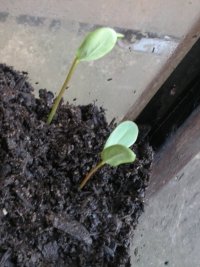
18/03/08 - These young Agati Trees (Sesbania grandiflora) sprouted within 4 days of planting during the 2nd quarter. That in itself is a good sign, as I have been unsucessful trying to germinate these trees in the past. Along with them have sprouted a Mexican Lilac Tree (Gliricidia sepium) & some Indian Shot (Canna indica). These are the first specimens that will be compared to others planted after the coming full moon.
22/3/08 - It is Easter Saturday. We've had two days of rain through the Good Friday full moon, which is the first since two nights that fell over the new moon. Admittedly, I have never taken notice of rain patterns in relation to the moon before & am struck by the immediate coincidence. So far at least, rain has fallen exactly as moon gardeners claim.
An unexpected factor in the moon experiment has proven to be my dog Chynna, who decided to dig up the artichoke & leek patch. Some sprouted regardless, rather quickly & the same can be said about snow peas. More artichokes, snow peas & silverbeet were planted prior to the full moon. Planting in the opposite phases will commence shortly after Easter.
12/5/08 - The waxing garden is finally established. There are snow peas, artichokes, leeks & beets growing, the latter two being root vegetables planted out of phase. I also have a number of agati trees, gliricidias & caesalpinias that were planted either side of the full moon. Those planted under the waxing moon in March are all doing well. Those that sprouted under the waning moon in April seem to be doing less well in the case of the agati trees but of course, its far too early to be draw any conclusions.
The cannas I gave to Daphne. She will raise them & some others that will be sprouted under May's waning moon. I enjoyed success under May's waxing moon, sprouting Pachypodium lamerii, Puya berteroniana, Puya venusta, Fascicularia bicolor & Ocotillo seeds. This alone has convinced me to continue the practice.
Copyright © www.100flowers.win Botanic Garden All Rights Reserved